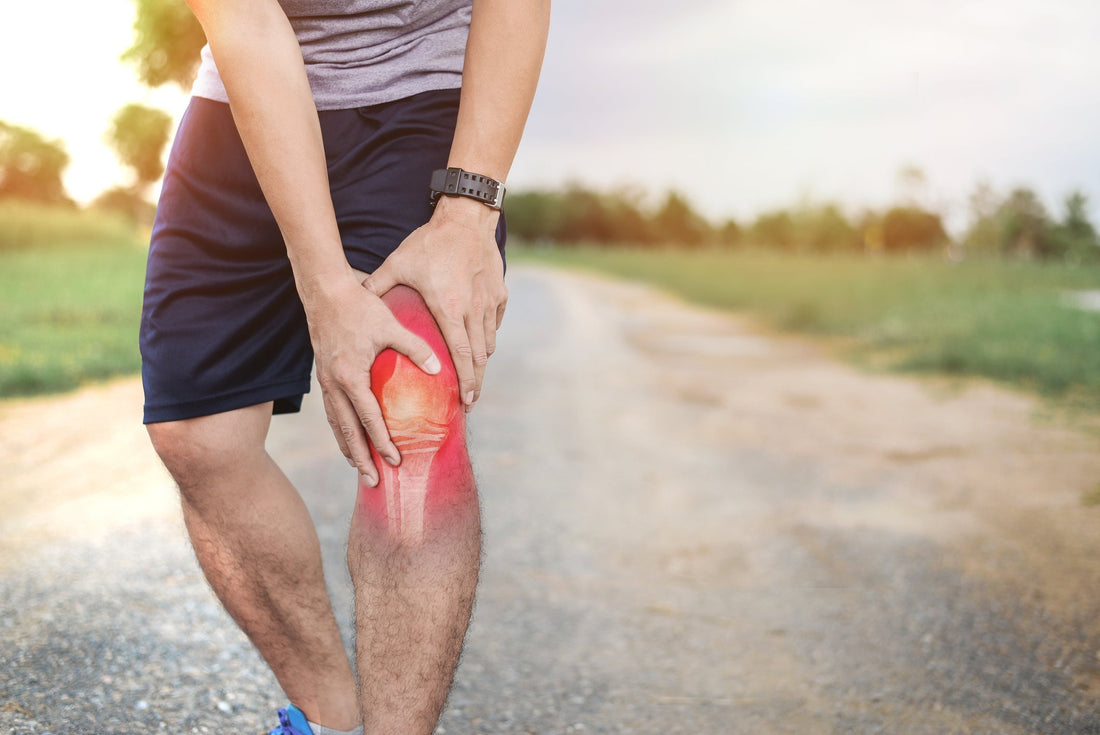Read Time: 8 min | Categories: Joint Health
What’s Causing your Joint Pain? Rheumatoid Arthritis vs. Osteoarthritis
Patience Lister, BSc
Share this article
Are sore, stiff joints making day-to-day life less comfortable? You could have arthritis.
Rheumatoid arthritis (RA) and osteoarthritis (OA) are the two most common forms of arthritis in Canadians. About one in seven Canadians has OA and one in 100 has RA. [1,2] But how do you know whether your joint pain and stiffness are from RA or OA?
The symptoms of RA and OA often overlap, and diagnosis can be tricky. Both conditions can, however, worsen over time without proper management.
Understanding the differences in underlying causes and treatments for RA and OA is critical to managing your arthritis effectively and slowing its progression.
What Causes Rheumatoid Arthritis vs. Osteoarthritis?
The symptoms of joint pain, stiffness, and inflammation that come with RA and OA may feel the same, but their underlying causes are very different.
RA is an autoimmune disease that causes your immune system to attack its own tissues. This includes attacking the delicate tissue surrounding your joints. If you have RA, immune cells found in the synovial membrane of your joints release proteins that damage the surrounding tissue. This triggers inflammation, leading to swollen, fluid-filled joints. [3]
In contrast, OA is a degenerative disorder caused by the physical breakdown of joint cartilage and underlying bones. [4] It also involves irregularities in the synovium, the soft tissue membrane lining your joints. [3] OA develops when your body fails to properly repair its joints from physical wear and tear. As your joint cartilage degrades, your joints lose cushioning, and bones that are normally separated can rub together. [4] Without the protection of healthy joint cartilage, the surrounding tissues and nerves become irritated.
Symptoms of Rheumatoid Arthritis vs. Osteoarthritis
Joint pain is joint pain, right? It’s not that simple.
Many of the symptoms of RA and OA overlap, making it difficult to pinpoint what is causing them. RA and OA both cause: [1,2]
- Painful joints
- Joint stiffness and restricted movement
- Swelling and inflammation in the joints
- Worse symptoms in the morning
There are also distinct differences between RA and OA symptoms that can help guide you in making the correct diagnosis. How you answer these questions may be key:
1. How long does your joint stiffness last?
With OA, stiffness typically improves after about 30 minutes. [1] Stiffness from RA typically lasts more than an hour. [2]
2. How many of your joints are stiff and painful?
RA is often widespread, spreading to multiple joints within as little as a few weeks. [2] OA is typically limited to a few specific joints. [1]
3. Do you feel lumps under the skin around your joints?
RA can cause firm lumps (nodules) to form close to your joints, most commonly on hands, fingers, knuckles, and elbows. [5] OA nodules are bony lumps that typically form on the joints at the middle and end of fingers. [6]
4. Is your joint pain accompanied by other symptoms?
RA is a systemic condition that may include fatigue, fever, or inflammation throughout the body. RA can affect joints, nerves, and other organs, such as the eyes, skin, and lungs. [2]
5. Do your sore joints grind or creak?
OA may cause joint crepitus, the sensation that your joints are grinding or the sound of creaking during movement. [1]
6. Are your hand and foot joints affected?
Comparing RA vs.OA in hands can be a good indication of which condition you may have. RA will likely involve both hands and feet. [7]
Which Joints are Affected by Rheumatoid Arthritis vs. Osteoarthritis?
Although RA and OA may affect some of the same joints, the pattern of how these joints are affected is different.
RA most commonly affects the hands, wrists, and knees, with symptoms felt symmetrically on both sides of the body. Symptoms often begin in a few joints and then spread to many others throughout the body over the course of weeks and months. [2,8]
OA most commonly affects the knee, hip, big toe, hand, and spine joints. It typically only affects a few joints, and not necessarily on both sides of the body. OA does, however, affect people differently. [1] Depending on specific lifestyle and physical activities, it can affect other types of joints.
Risk Factors of Rheumatoid Arthritis vs. Osteoarthritis
Despite having very different underlying causes, RA and OA share a few similar risk factors. These include greater risks for: [2,4]
- Older people
- Women
- People with a family history of arthritis
But these aren’t the only risk factors.
Other risk factors of RA include: [2]
- Hormonal changes because of pregnancy, breastfeeding, or oral contraceptives
- Infection
- Smoking
Other risk factors of OA include: [4]
- Being overweight
- Physical injury or joint deformity
- Doing repetitive movements during work or exercise
- Having weak muscles or ligaments
- A sedentary lifestyle
Diagnosing your Arthritis

Tracking your symptoms is the first step toward identifying the type of arthritis you have, followed by an official diagnosis by a qualified health care practitioner. With both RA and OA, the earlier you get the right diagnosis, the easier it’ll be to manage your condition.
Many of the steps to diagnosing RA and OA are the same. They will likely include: [1,2]
- Physical examination of your joints
- Taking a detailed medical history
- Medical imaging, such as an X-ray to identify joint damage
If your health care practitioner suspects RA, a blood test that measures signs of inflammation or RA biomarkers (C-reactive protein, anti-citrullinated protein antibodies, and rheumatoid factors) can also help confirm your diagnosis. [2]
Managing Rheumatoid Arthritis vs. Osteoarthritis
Although RA and OA are chronic conditions that cannot be cured, there are actions that you can take to help minimize your symptoms. Finding the right management plan is critical to slowing the progression of your arthritis and improving your quality of life. Managing either type of arthritis can involve: [9]
- Making healthy lifestyle modifications. Losing excess body weight is recommended for anyone with OA, while quitting smoking is a priority for RA patients. [9,10]
- Staying active with joint-friendly exercises like swimming and biking. This is important for both RA and OA patients. [9]
- Eating a diet of whole, unprocessed foods, including anti-inflammatory and antioxidant-rich foods. This is recommended for both RA and OA patients. [11,12]
- Keeping stress levels low to prevent joint paint caused by stress. [13]
- Regular physical therapy to increase flexibility and strengthen the muscles surrounding your joints. This is important for both RA and OA patients. [9]
- Taking anti-inflammatory therapies to help alleviate pain and irritation in the joint tissue. The therapy you use will depend on whether you have OA or RA. [7,14]
Best Supplements for Rheumatoid Arthritis vs. Osteoarthritis
Various natural health supplements can be used as part of your RA or OA management strategy to help reduce inflammation and tissue damage. Choosing the right supplement for your needs will depend on whether you have RA or OA.
Webber Naturals’ line of joint health supplements includes formulas suited for RA and OA. These offer targeted support for your joints and are available in liquid, softgel, and capsule formats. Three fantastic options include:
- Glucosamine Chondroitin Double Strength – This formula is used to protect against cartilage deterioration and relieve OA pain. It is an excellent supplement for athletes and active people concerned about physical wear and tear of their joints.
- Triple Strength Omega-3 – By providing a concentrated source of the essential fatty acids EPA and DHA, this formula makes a great choice for anyone with RA. Supplementing with EPA and DHA in conjunction with conventional therapy has been shown to help reduce the pain caused by RA.
- Turmeric Curcumin 3050 mg – Turmeric is used in herbal medicine to help with inflammation and reduce joint stiffness and pain. This formula contains 50 mg of turmeric extract standardized to 95% curcuminoids plus 550 mg of turmeric powder for concentrated joint support.
To pick the right joint health supplement for either RA or OA, be sure to read the article "How to choose the best joint health supplements for you".
A Quick-look Chart for Rheumatoid Arthritis vs. Osteoarthritis
| Rheumatoid Arthritis | Osteoarthritis | |
|---|---|---|
| Cause | Autoimmune disease – immune system attacks the body’s own tissues | Physical wear and tear – joint cartilage and underlying bones break down |
| Symptoms | Joint pain, morning stiffness lasting more than an hour, affects many joints, symmetrical pain, fatigue, fever, inflammation of organs, joint nodules | Joint pain and swelling, morning stiffness lasting less than 30 minutes, affects only a few joints, pain not on both sides, grinding or creaking joints, decreased flexibility |
| Joints affected | Hands, wrists, knees, feet | Knee, hip, big toe, hand, spine |
| Risk factors | Aging, female, family history of RA, hormone changes, infection, smoking | Aging, female, family history of OA, being overweight, joint injury or deformity, repetitive physical activity, weak muscles or ligaments, sedentary lifestyle |
| Diagnosis steps | Physical exam, medical history, x-ray, blood test | Physical exam, medical history, x-ray |
| Management | Not smoking, stress reduction, joint-friendly exercises, wholefood, anti-inflammatory diet, physical therapy | Weight loss, joint-friendly exercises, wholefood, anti-inflammatory diet, physical therapy |
| Supplements | Omega-3 fatty acids, turmeric, MSM, methylsulfonylmethane | Glucosamine and chondroitin, turmeric, collagen, NEM, MSM, methylsulfonylmethane |
